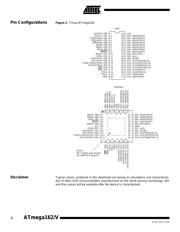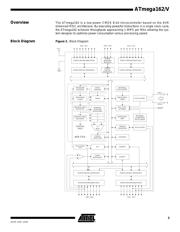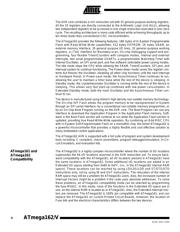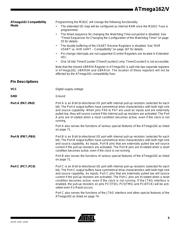Datasheet 搜索 > 微控制器 > ATMEL(爱特美尔) > ATMEGA162V-8MI 数据手册 > ATMEGA162V-8MI 其他数据使用手册 4/323 页
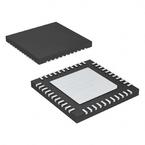
¥ 0
ATMEGA162V-8MI 其他数据使用手册 - ATMEL(爱特美尔)
制造商:
ATMEL(爱特美尔)
分类:
微控制器
封装:
VFQFN-44
Pictures:
3D模型
符号图
焊盘图
引脚图
产品图
页面导航:
引脚图在P2P5P64Hot
原理图在P3P7P62P88P90P91P92P106P111P112P114P116
封装尺寸在P310P311P312
型号编码规则在P309P314P315
封装信息在P310P314
技术参数、封装参数在P314
应用领域在P30P31P40P46P58P60P216P219P230P231
电气规格在P62P314P315
导航目录
ATMEGA162V-8MI数据手册
Page:
of 323 Go
若手册格式错乱,请下载阅览PDF原文件

4
ATmega162/V
2513F–AVR–12/03
The AVR core combines a rich instruction set with 32 general purpose working registers.
All the 32 registers are directly connected to the Arithmetic Logic Unit (ALU), allowing
two independent registers to be accessed in one single instruction executed in one clock
cycle. The resulting architecture is more code efficient while achieving throughputs up to
ten times faster than conventional CISC microcontrollers.
The ATmega162 provides the following features: 16K bytes of In-System Programmable
Flash with Read-While-Write capabilities, 512 bytes EEPROM, 1K bytes SRAM, an
external memory interface, 35 general purpose I/O lines, 32 general purpose working
registers, a JTAG interface for Boundary-scan, On-chip Debugging support and pro-
gramming, four flexible Timer/Counters with compare modes, internal and external
interrupts, two serial programmable USARTs, a programmable Watchdog Timer with
Internal Oscillator, an SPI serial port, and five software selectable power saving modes.
The Idle mode stops the CPU while allowing the SRAM, Timer/Counters, SPI port, and
interrupt system to continue functioning. The Power-down mode saves the register con-
tents but freezes the Oscillator, disabling all other chip functions until the next interrupt
or Hardware Reset. In Power-save mode, the Asynchronous Timer continues to run,
allowing the user to maintain a timer base while the rest of the device is sleeping. In
Standby mode, the crystal/resonator Oscillator is running while the rest of the device is
sleeping. This allows very fast start-up combined with low-power consumption. In
Extended Standby mode, both the main Oscillator and the Asynchronous Timer con-
tinue to run.
The device is manufactured using Atmel’s high density non-volatile memory technology.
The On-chip ISP Flash allows the program memory to be reprogrammed In-System
through an SPI serial interface, by a conventional non-volatile memory programmer, or
by an On-chip Boot Program running on the AVR core. The Boot Program can use any
interface to download the Application Program in the Application Flash memory. Soft-
ware in the Boot Flash section will continue to run while the Application Flash section is
updated, providing true Read-While-Write operation. By combining an 8-bit RISC CPU
with In-System Self-Programmable Flash on a monolithic chip, the Atmel ATmega162 is
a powerful microcontroller that provides a highly flexible and cost effective solution to
many embedded control applications.
The ATmega162 AVR is supported with a full suite of program and system development
tools including: C compilers, macro assemblers, program debugger/simulators, In-Cir-
cuit Emulators, and evaluation kits.
ATmega161 and
ATmega162
Compatibility
The ATmega162 is a highly complex microcontroller where the number of I/O locations
supersedes the 64 I/O locations reserved in the AVR instruction set. To ensure back-
ward compatibility with the ATmega161, all I/O locations present in ATmega161 have
the same locations in ATmega162. Some additional I/O locations are added in an
Extended I/O space starting from 0x60 to 0xFF, (i.e., in the ATmega162 internal RAM
space). These locations can be reached by using LD/LDS/LDD and ST/STS/STD
instructions only, not by using IN and OUT instructions. The relocation of the internal
RAM space may still be a problem for ATmega161 users. Also, the increased number of
Interrupt Vectors might be a problem if the code uses absolute addresses. To solve
these problems, an ATmega161 compatibility mode can be selected by programming
the fuse M161C. In this mode, none of the functions in the Extended I/O space are in
use, so the internal RAM is located as in ATmega161. Also, the Extended Interrupt Vec-
tors are removed. The ATmega162 is 100% pin compatible with ATmega161, and can
replace the ATmega161 on current Printed Circuit Boards. However, the location of
Fuse bits and the electrical characteristics differs between the two devices.
器件 Datasheet 文档搜索
AiEMA 数据库涵盖高达 72,405,303 个元件的数据手册,每天更新 5,000 多个 PDF 文件


